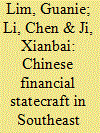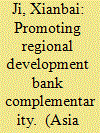| Srl | Item |
| 1 |
ID:
185987


|
|
|
|
|
| Summary/Abstract |
Since 2013, the Belt and Road Initiative has become China’s signature foreign economic policy campaign. While there have been debates on the initiative’s implementation and implications, an emerging consensus suggests that the export of capital-intensive infrastructure is a key driving factor of China’s financial statecraft. For Southeast Asian countries, such Chinese efforts are useful in plugging their domestic infrastructure gaps, not least in the remote parts of their territory. Against this backdrop, this article examines arguably two of the most prominent Chinese infrastructure projects in Malaysia – the East Coast Rail Link (ECRL) and the Malaysia-China Kuantan Industrial Park (MCKIP). It posits three inter-related arguments. Firstly, unlike conventional analyses which commonly treat the Chinese state as a singular, unitary actor, both the central and provincial governments in China’s multi-layer state structure have played important roles and demonstrated different characteristics in Chinese infrastructure overture towards Malaysia. Secondly, one observes contrasting patterns of well-coordinated state-business relations in the ECRL project versus loose, decentralised state-business relations driven largely by Guangxi province and market forces for the MCKIP. Thirdly, the implementation of both the ECRL and the MCKIP has been heavily constrained by the political-institutional environment of Malaysia as the host country, illustrating that Chinese financial statecraft, in the form of infrastructure provision, generates considerably less impact than what popular rhetoric suggests.
|
|
|
|
|
|
|
|
|
|
|
|
|
|
|
|
| 2 |
ID:
154429


|
|
|
|
|
| Summary/Abstract |
As the international development finance architecture decentralises, a plethora of regional multilateral development banks (MDBs) emerge. The institutional landscape in Asia is transforming with the establishment of the Asian Infrastructure Investment Bank (AIIB). This paper aims to shed light on the horizontal relationship between the traditional development actor, the Asian Development Bank (ADB), and the nascent AIIB. Based on the collaborative experiences of the European Investment Bank (EIB) and the European Bank for Reconstruction and Development (EBRD), this article recommends that ADB and the AIIB should form tri-partite coordination mechanism to promote cooperation, develop complementary portfolios in terms of sectoral exposure and geographical coverage and co-fund projects to catalyse greater inter-agency cooperation. The resulting synergies will stitch the two institutions into an interdependent and coherent development finance structure in Asia and beyond.
|
|
|
|
|
|
|
|
|
|
|
|
|
|
|
|